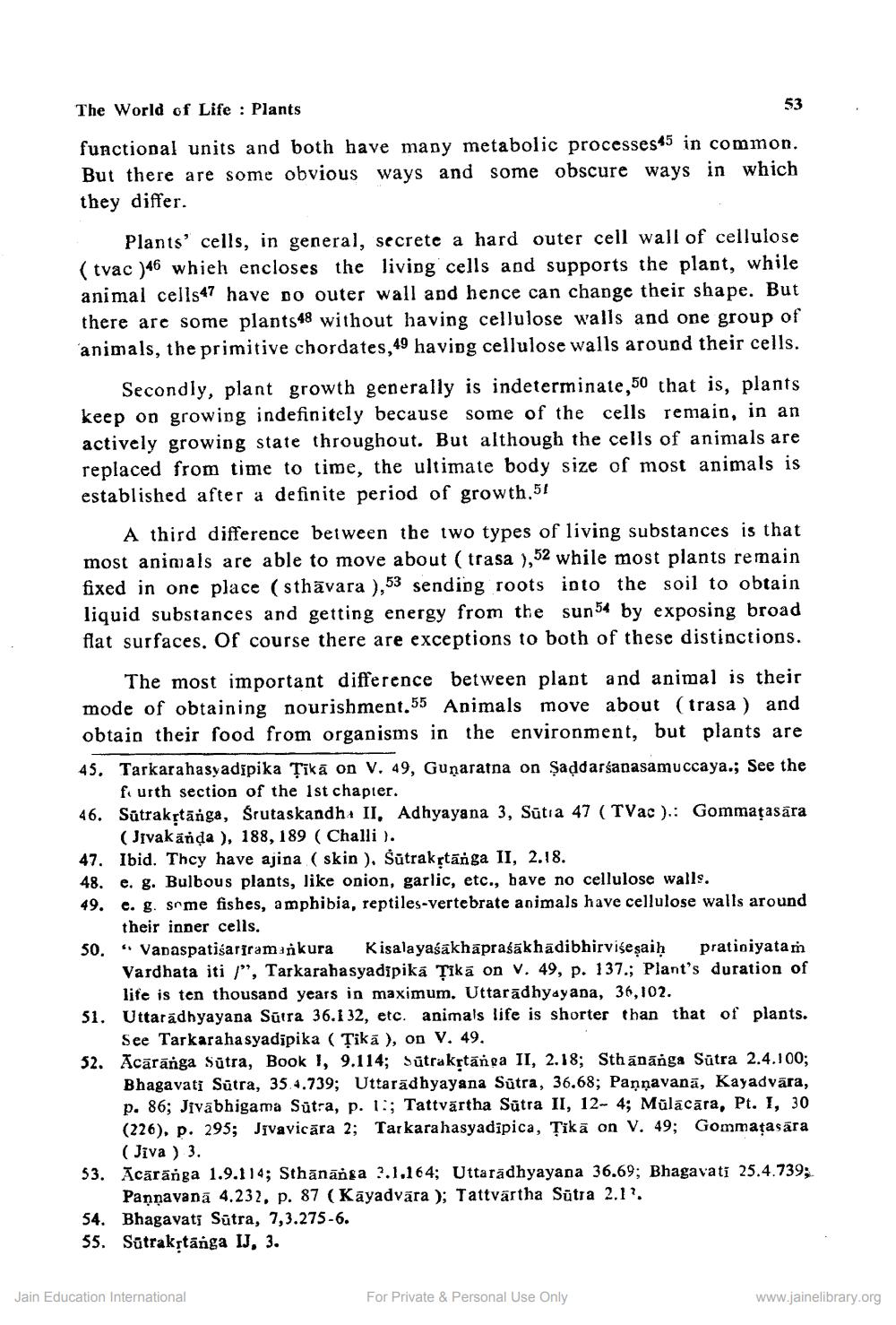________________
.
The World of Life : Plants
53 functional units and both have many metabolic processes45 in common. But there are some obvious ways and some obscure ways in which they differ.
Plants' cells, in general, secrete a hard outer cell wall of cellulose (tvac )46 whieh encloses the living cells and supports the plant, while animal cells47 have no outer wall and hence can change their shape. But there are some plants48 without having cellulose walls and one group of animals, the primitive chordates, 49 having cellulose walls around their cells.
Secondly, plant growth generally is indeterminate, 50 that is, plants keep on growing indefinitely because some of the cells remain, in an actively growing state throughout. But although the cells of animals are replaced from time to time, the ultimate body size of most animals is established after a definite period of growth.51
A third difference beiween the two types of living substances is that most animals are able to move about (trasa ),52 while most plants remain fixed in one place (sthāvara ),53 sending roots into the soil to obtain liquid substances and getting energy from the sun 54 by exposing broad flat surfaces. Of course there are exceptions to both of these distinctions.
The most important difference between plant and animal is their mode of obtaining nourishment.55 Animals move about (trasa ) and obtain their food from organisms in the environment, but plants are 45. Tarkarahasyadipika Tikā on V, 49, Gunaratna on şaddarsanasamuccaya.; See the
fi urth section of the 1st chapter. 46. Sūtrakrtānga, Śrutaskandhı II, Adhyayana 3, Sūtia 47 (TVac ).: Gommatasara
(Jivakānda ), 188, 189 ( Challi ). 47. Ibid. They have ajina ( skin ), Sūtrakstānga II, 2.18. 48. e. g. Bulbous plants, like onion, garlic, etc., have no cellulose walls. 49. e. g. srme fishes, amphibia, reptiles-vertebrate animals have cellulose walls around
their inner cells. " Vanaspatiśariramanikura Kisala yasakhaprašākhadibhirvisesaih pratioiyatam Vardhata iti /", Tarkarahasyadipika rīkā on v. 49, p. 137.; Plant's duration of
life is ten thousand years in maximum. Uttarādhyayana, 36,102. 51. Uttaradhyayana Sūtra 36.132, etc. animals life is shorter than that of plants.
See Tarkaraha syadipika ( Tikā ), on V. 49. 52. Acārānga Sūtra, Book I, 9.114; Sūtrakrtānga II, 2.18; Sthānanga Sūtra 2.4.100;
Bhagavati Sūtra, 35.4.739; Uttaradhyayana Sūtra, 36.68; Pannavanā, Kayadvāra, p. 86; Jivabhigama Sutra, p. 1:; Tattvārtha Sūtra II, 12- 4; Mülācāra, Pt. I, 30 (226), p. 295; Jivavicāra 2; Tarkarahasyadipica, Țikā on V. 49; Gommațasara (Jiva ) 3. Acaränga 1.9.114; Sthānānea 2.1.164; Uttaradhyayana 36.69; Bhagavati 25.4.739;
Pannavanā 4.232, p. 87 (Kāyadvāra ); Tattvärtha Sūtra 2.1?. 54. Bhagavati Sūtra, 7,3.275-6. 55. Sūtrakstānga IJ, 3.
53.
Jain Education International
For Private & Personal Use Only
www.jainelibrary.org




